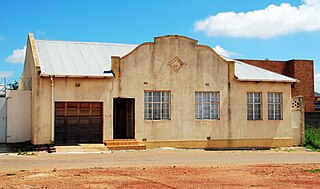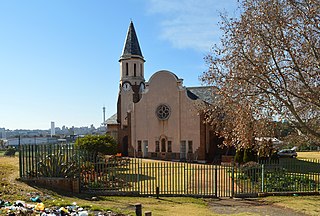
Soweto is a township of the City of Johannesburg Metropolitan Municipality in Gauteng, South Africa, bordering the city's mining belt in the south. Its name is an English syllabic abbreviation for South Western Townships. Formerly a separate municipality, it is now incorporated in the City of Johannesburg Metropolitan Municipality, and one of the suburbs of Johannesburg.

Johannesburg is a large city in Gauteng Province of South Africa. It was established as a small village controlled by a Health Committee in 1886 with the discovery of an outcrop of a gold reef on the farm Langlaagte. The population of the city grew rapidly, becoming a municipality in 1898. In 1928 it became a city making Johannesburg the largest city in South Africa. In 2002 it joined ten other municipalities to form the City of Johannesburg Metropolitan Municipality. Today, it is a centre for learning and entertainment for all of South Africa. It is also the capital city of Gauteng.
Aggrey Zola Klaaste was a South African newspaper journalist and editor. He was best known for being editor of the Soweto-based newspaper, the Sowetan, from 1988 to 2002. He introduced the concept of "nation building" while editor of the Sowetan and spent much of his time and energy promoting the idea.
Dobsonville is an suburb in Soweto.
Meadowlands is a suburb of Soweto, Gauteng Province, South Africa. It was founded in the early 1950s during the apartheid era for black residents from Sophiatown.
Ennerdale is a town in Gauteng, South Africa. Ennerdale was declared as a coloured group area under the apartheid regime.

The suburbs of Johannesburg are officially demarcated areas within the City of Johannesburg Metropolitan Municipality, South Africa. As in other Commonwealth countries, the term suburb refers to a "neighbourhood", although in South Africa as most "suburbs" have legally recognised borders and often separate postal codes. The municipal functions for the area, such as municipal policing and social services, are still managed by the city government.
Bertrams is a suburb of Johannesburg, South Africa. It is a small suburb found on the eastern edge of the Johannesburg central business district (CBD), tucked between the suburbs of New Doornfontein and Lorentzville, with Troyeville to the south. It is located in Region F of the City of Johannesburg Metropolitan Municipality.

Pageview is a suburb of Johannesburg, South Africa. It is located in Region F of the City of Johannesburg Metropolitan Municipality. Populated by non-whites, predominantly Indians, until the 1970s, it was one of two adjacent suburbs commonly known as Fietas.
Orlando is a township in the urban area of Soweto, South Africa. The township was founded in 1931 and named after Edwin Orlando Leake, Mayor of Johannesburg from 1925 to 1926. It is divided in two main areas: Orlando West and Orlando East.

Kliptown is a suburb of the formerly black township of Soweto in Gauteng, South Africa, located about 17 km south-west of Johannesburg. Kliptown is the oldest residential district of Soweto, and was first laid out in 1891 on land which formed part of Klipspruit farm. The farm was named after the klipspruit that runs nearby. From 1903 the area was home to informal settlements, and the area now contains a mixture of purpose-built housing and many shacks and other informal homes which form the Chris Hani and Dlamini settlements.

Regina Mundi, designed by architect Anthony Noel Errol Slaven, is the largest Roman Catholic church in South Africa. It is located in Rockville, Soweto, a populous black urban residential area within the city of Johannesburg. Due to the role it played as a place of gathering for the people of Soweto in the years before, during, and after the anti-apartheid struggle, it is often referred to as "the people's church" or "the people's cathedral".

Vrededorp is a suburb of Johannesburg, South Africa. It is located in Region F of the City of Johannesburg Metropolitan Municipality. Vrededorp is situated on the North-Western side of Johannesburg and is 1,764 m (5,788 ft) above sea level.
Mary Malahlela-Xakana was the first black woman to register as a medical doctor in South Africa. She was also a founding member of the Young Women’s Christian Association.
Ashby Solomzi Peter Mda, also known as A. P. Mda was a South African teacher, lawyer, political activist and co founder of the African National Congress Youth League (ANCYL). He was also one of the founders of the Pan Africanist Congress of Azania.
Eldorado Park is a suburb of Soweto, Johannesburg, South Africa. It is located in Region G of the City of Johannesburg Metropolitan Municipality. It lies on the southern boundary of Soweto and prior to 1994, was a Coloured township during Apartheid.
Ellen Hellmann was a South African social anthropologist and the first woman to graduate with a D.Phil. degree from the University of Witwatersrand.
The M10 is a long metropolitan route in Greater Johannesburg, South Africa. It connects Lenasia with Johannesburg Central via Soweto.
The M70 road is a short metropolitan route in Johannesburg, South Africa. It connects Booysens with Dobsonville via Diepkloof, Orlando and Meadowlands. For much of its route, it is known as the Soweto Highway.
The M79 is a short metropolitan route in Johannesburg, South Africa. On physical street signs, it is signposted as the M12 on the eastern part of the route.








